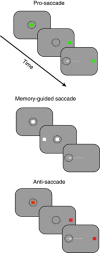The cortex is in overall control of 'voluntary' eye movement
- PMID: 25475239
- PMCID: PMC4330293
- DOI: 10.1038/eye.2014.284
The cortex is in overall control of 'voluntary' eye movement
Abstract
The neural circuits that control eye movements are complex and distributed in brainstem, basal ganglia, cerebellum, and multiple areas of cortex. The anatomical function of the substrates implicated in eye movements has been studied for decades in numerous countries, laboratories, and clinics. The modest goal of this brief review is twofold. (1) To present a focused overview of the knowledge about the role of the cerebral cortex in voluntary control of eye movements. (2) To very briefly mention two findings showing that the accepted hierarchy between the frontal and the occipital sensory areas involved in sensory-motor transformation might not be so trivial to reconcile, and to interpret in the context of eye movement command. This presentation has been part of the 44th Cambridge Ophthalmological Symposium, on ocular motility, 3 September 2014 to 5 November 2014.
Figures
References
-
- Lemon R. Methods for neuronal recording in conscious animals. John Wiley and Sons: Chichester, UK; 1984.
-
- Deffieux T, Younan Y, Wattiez N, Tanter M, Pouget P, Aubry JF. Low-intensity focused ultrasound modulates monkey visuomotor behavior. Curr Biol. 2013;23 (23:2430–2433. - PubMed
-
- Gerits A, Ruff CC, Guipponi O, Wenderoth N, Driver J, Vanduffel W. Transcranial magnetic stimulation of macaque frontal eye fields decreases saccadic reaction time. Exp Brain Res. 2011;212 (1:143–152. - PubMed
-
- Müri RM, Nyffeler T. Neurophysiology and neuroanatomy of reflexive and volitional saccades as revealed by lesion studies with neurological patients and transcranial magnetic stimulation (TMS) Brain Cogn. 2008;68 (3:284–292. - PubMed
Publication types
MeSH terms
LinkOut - more resources
Full Text Sources
Other Literature Sources



